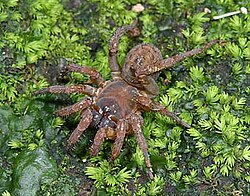Kimura spider
| Kimura-gumo | |
|---|---|

| |
| female | |
| Scientific classification | |
| Kingdom: | |
| Phylum: | |
| Class: | |
| Order: | |
| Suborder: | |
| Family: | |
| Genus: | |
| Species: | H. kimurai
|
| Binomial name | |
| Heptathela kimurai | |
The kimura-gumo or kimura spider (Heptathela kimurai) is an Old World spider, found primarily in Japan and named after Kimura Arika, who discovered it in 1920. It belongs to the sub-order Mesothelae (primitive burrowing spiders) and can reach up to 3 cm in length. Its burrows are covered by a camouflaged "pill box" flap.
The ancestral traits of the Kimura-gumo include central spinnerets and signs of segmentation on the abdomen. These features are not seen on modern spiders, thus studying the Kimura-gumo can shed light on the evolution of all spiders.
Although kimura spiders lack venom glands, they still have strong chelicerae and can produce quite painful bites[1].

The word kumo in Japanese means spider. ("Gumo" is a variation in pronunciation due to a phenomenon known as rendaku.) The sub-order this spider is a member of, Mesothelae, is about 400 million years old, placing the kimura spider among the most primitive living spiders. Its spinnerets are located in the middle of the body, as opposed to the more efficient location in modern spiders at the rear of the abdomen. It fixes its eggs on the surface of its burrow with silk so that they are well protected. The spider surrounds tunnels also with a cobweb. When it sets out on a hunt, it pays out a line of silk behind it. This "lifeline" helps it in orienting itself.
There are a number of Heptathela kimurai subspecies including; H. k. amamiensis, H. k. higoensis, H. k. yanbaruensis and H. k. yakushimaensis [2].
References
- Tomo Kočar, Strah je okrogel in ima osem nog (The fear is round and it has eight legs), GEA 12 (2002) 7, pp 46 - 49.
- Yoshikura, M. 1982. Kumo no fushigi (The wonder of spiders). Iwanami-shoten, Tokyo.
